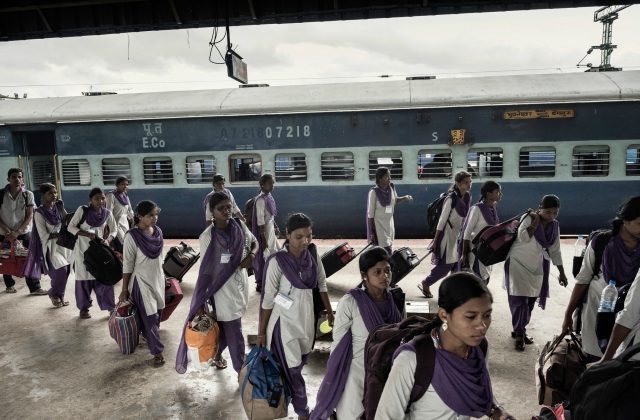'Everyone Knows That India Is a Hard Place for Women'

Girls arriving in Bangalore in June from rural villages for their new factory jobs. (Andrea Bruce/New York Times)
During India's economic boom over the last decade and a half, observers began to notice a surprising fact: Tens of millions of women were dropping out of the labor force, defying economists' understanding that economic growth and female labor force participation were positively correlated.
Ellen Barry, who became the New York Times' South Asia Bureau Chief in 2013, sought to find out why so many Indian women were no longer working. Her research and reporting brought her in contact with two extraordinary pairs of young women: Geeta and Premwati, who defied an order to stop working in a rural village at tremendous personal risk; and Shashi and Prabwati, whose journey from a small village to bustling Bangalore involved many twists of fate. In two articles encompassing these stories, Barry weaves a gripping narrative with an in-depth look at India's often uncertain lurch toward modernity.
In recognition of these profiles of India's young women as well as numerous other stories throughout South Asia, Asia Society has awarded Barry with the Osborn Elliott Prize for Excellence in Journalism on Asia. Barry, who will move to London for a new assignment with the Times later this year, will accept her award during a ceremony at Asia Society in New York on May 23.
Asia Blog recently caught up with Barry to talk about the experience of reporting in India, a country rushing headlong into modernity. The interview has been lightly edited for clarity.
Your articles focus on the fate of young women trapped between traditional life and encroaching modernity in India’s countryside. How did this subject first pique your interest?
When I was posted in India four years ago, the world was beginning to take notice of India’s expansion. Russia was swooning after a collapse in the price of oil, and China’s 30-year boom had slowed. India, by contrast, was poised for many years of moderate, sustained growth: By 2050 it is projected to edge out the United States and China as the world’s largest economy. This buzz of growth and expectation was everywhere: Farmers were incurring terrible debts to send their children to private schools to learn English in hopes that they would land an office job, a call center job — anything, really, other than farming. Fly-by-night colleges were popping up in farmland surrounding cities, with names like Logic Shining Academy and Tetrahedron Junior College. The election of Narendra Modi in 2013 seemed rooted in this sense of expectation: The whole country seemed poised to take a leap.
I wondered how this economic boom would affect India’s women and was shocked to look at the statistics. Something strange was going on. Around 70 million Indian women dropped out of the labor force between 2000 and 2012, largely rural women who were no longer employed on farms. Women’s participation in the labor force in India now stands at 22 percent, the second lowest of all the G-20 economies, trailed only by Saudi Arabia. This was happening despite the economic expansion, a sharp drop in fertility rates, and a swift rise in education levels in addition to urbanization, trade liberalization, and the globalization of labor. In 2012, the last time the government surveyed its citizens about their occupation, an astonishing 205 million women between the ages of 15 and 60 responded “attending to domestic duties.”
I wanted to find ways to bring this abstract economic story alive for readers. Everyone knows that India is a hard place for women. News coverage, especially from the foreign press, is full of acid attacks, dowry killings, honor killings, immolations, female feticide, gang rape, and any other number of violent acts. I came to believe that economic factors, rather than religious dogma, were at the root of the place women occupy in rural India, and that market forces can be marshaled to change them. I began to look for compelling narratives with strong protagonists that might persuade my audience to pay attention.
The narrative of each article is driven by two pairs of women — Geeta and Premwati, who refuse an order to cease work in Meerut; and Shashi and Prabwati, sisters who migrate to Bangalore in search of factory jobs. How did you determine that these women would be your subjects?
In the first case, it was relatively easy: Geeta had rebelled against the village by continuing to work, so when I met her she was an outcast. She was as mad as a wet cat. I remember, during one of my first visits, that she kind of sauntered into this ring of women I was talking to, raked over each of them with her eyes, and then turned to me and said, “None of these women is my friend.” It was cinematic — it reminded me of [Gone With the Wind's] Scarlett O’Hara walking into Ashley Wilkes’ birthday party after she had been caught kissing him. In Indian villages, where the state is weak or even nonexistent, social exclusion is the most powerful weapon available to the patriarchy. It was shocking to see someone defy that.
Geeta’s friend, Premwati, was basically the only person who would put up with her. She was not a born rebel, and she had more to lose. She lost it, gradually, over the course of months. I suppose I needed her in the story for that reason. In the end (as I always tell my six-year-old) the bravest people are not the ones like Geeta, who are not afraid to take a risk, but the ones who are afraid and do it anyway. I liked Premwati and she became the moral center of the story.
In the factory piece, it was more difficult to choose main characters. The people I was writing about were village girls who had just been plopped down in the city for the first time in their lives and given a striking amount of freedom. I had four or five months to finish the story, so was looking for characters who would undergo some change. So I was following eight or 10 young women closely, waiting for something to happen. When Prabhati was sent home her roommates in the hostel were depressed. She had such a strong will to break free of the life laid out for her in the village, maybe the strongest of all of them, and it seemed especially painful that she was the one sent home.
In each case, though, the main consideration in choosing subjects was whether they were comfortable letting me write about their lives, for a newspaper that was accessible from India. I worked for many weeks on a third story but could not find anyone willing to allow me to use their real names, so I ran out of time.
What challenges did you encounter in earning the trust of your subjects? Were they initially reluctant to be profiled? Did your status as a foreign person writing for an American newspaper reassure your subjects — or have the opposite effect?
In Peepli Khera, the people were so far removed from the world of the New York Times that they were indifferent to what I wrote. The biggest problem was that the first 20 times I walked into the village everyone stopped what they were doing and amused themselves by watching me. It was impossible to document ordinary life until I became boring to them.
Our presence did affect things. The neighbors made sure not to commit acts of violence in our presence — violence was a thread that ran through the fabric of the village. The chief of the village once pushed me out of town with his hands, and I had the awful feeling that it was because they planned to beat someone. When I arrived in the morning, people would come up to me and whisper in my ear, telling me what had occurred the night before. I brought them the newspaper afterward, and read parts of it aloud. They cared less than I expected about what I wrote.

Access was much more tricky on the second story. Western garment buyers try to avoid any coverage in the foreign press since most of it is focused on the poor working conditions and low pay. I had to work very hard to maintain my relationships with the factory management, the training program, and the warden of the hostel. That was a bit of a tightrope walk. The young women themselves were for the most part happy to have us there because my translator was their age and spoke Oriya, their language. When that story came out, I offered to have it translated into Oriya so their families could read it but Shashi asked me very sincerely not to because she thought it would put her in danger.
Did you encounter resistance and pressure from Indian authorities in the course of reporting your stories?
No. I think the problem of women withdrawing from the workforce is beginning to attract attention in the Indian government, in part because economists are warning that if the trend continues India will not fulfill its economic potential. Last year, Christine Lagarde, chief of the International Monetary Fund, said that India’s GDP could be expanded by 27 percent if women’s participation in the workforce was brought up to the level of men’s.
Your stories discuss isolated individuals and communities once far removed from modernity thrust into contact with the global economy and the Indian state. Do you think these collisions are bringing India together closer as a nation? Or do you think they might have a destabilizing effect?
I think they’re doing both things.
During the time I was reporting these stories, there were louder and louder rumbles of discontent coming from the West, where people were lamenting the loss of low-end manufacturing. I suppose what I could see from my end was that these rock-bottom manufacturing jobs, as they rippled out, had a tremendous effect on the society, especially when they pulled women into the workforce. Small kids in places like Peepli Khera often have symptoms of protein malnutrition, as if they were raised in a famine, because they eat nothing but flatbread and salt. When the women got jobs, they spent the extra income on food. Those kids got lentils and vegetables twice a day. It can be difficult to convey the story of hundreds of millions of people moving out of dire poverty, but I think it looks like children eating protein twice a day.
And it’s true, there is also a destabilizing effect, a kind of kickback that comes when the architecture of social control is challenged. Caste leaders want to preserve the tradition of arranged marriage. Mothers-in-law want to keep their daughters-in-law as sources of free labor. Moneylenders want to protect their profit margins. And all these things are disrupted by new flows of income, particularly when it flows through the hands of women. That’s why women breaking norms get into trouble. But, as I witnessed in Peepli Khera, rather to my amazement, they seem willing to accept the trouble.
What are some steps the Indian government can take to help more rural women thrive in the workforce?
The government needs to give assistance to women migrating for work. There should be large dormitories for working women in cities like Bangalore, something that China did effectively. India spends huge sums on job training programs for poor men and women, but the programs have a high dropout rate, in part because of migration. I think it would help to connect these skill-development programs to smaller enterprises. Firms should be encouraged to build plants close to the work force. Pathways to employment and financial literacy should be presented to adolescent girls, during that “golden hour” before they go into arranged marriages. They should be allowed to join self-help groups, taught to use mobile phones and bank accounts. Finally, the message should go out through the society — through TV and film and the words of India’s leaders — that a working daughter or daughter-in-law is something to be proud of.
What did you consider to be your greatest challenges — and most gratifying moments — as the New York Times’ South Asia Bureau Chief?
It is difficult to frame reporting on India for an American newspaper without stumbling into hoary clichés and sloppy generalizations and outright errors of fact. It’s a complex system that becomes more complex the closer you look. At the beginning, I kept thinking I had discovered something completely original and discovering that it had been true for 1,000 years and written by eight of my predecessors. Indian news is full of scandals and controversies that can take up all your attention for four years but ultimately mean nothing. Finding a line of reporting that is original and matters is a big challenge.
The gratifying moments are so many that I cannot begin to catalog them. I envy anyone lucky enough to be able to report in India. Once, while reporting on a corruption charge against Jayalalithaa, the movie-star empress of Tamil Nadu, I drank a cup of freezing-cold grape juice that was so delicious that I smacked into a pole and injured my face. That happened a lot the first year.
I was exhilarated to come here from Russia and realize I was among people who felt free to criticize their government. I remember once interviewing a regional strongman, and getting a response so pungent that I stopped what I was doing and offered him anonymity. (Needless to say, I am not in the habit of doing this very often.) And the guy looked at me uncomprehendingly and said, no, that’s what I really think, so I’d like put my name on it. I love this about South Asia.
Soon you’ll be moving to London to become the Times’ chief international correspondent, a posting in which you’ll “follow story lines across borders to land signature enterprise pieces.” What most excites you about this opportunity?
I’ve spent the last nine years in Russia and India, economies that felt themselves growing stronger and more confident as the American-led international order weakened. [Vladimir] Putin and Modi are path-breaking leaders who tapped into a deep vein of national identity, leading their populations into a period of unchecked regional power. I am excited to move to Europe, the place where liberal internationalism was born, at a time when that idea is under pressure.


